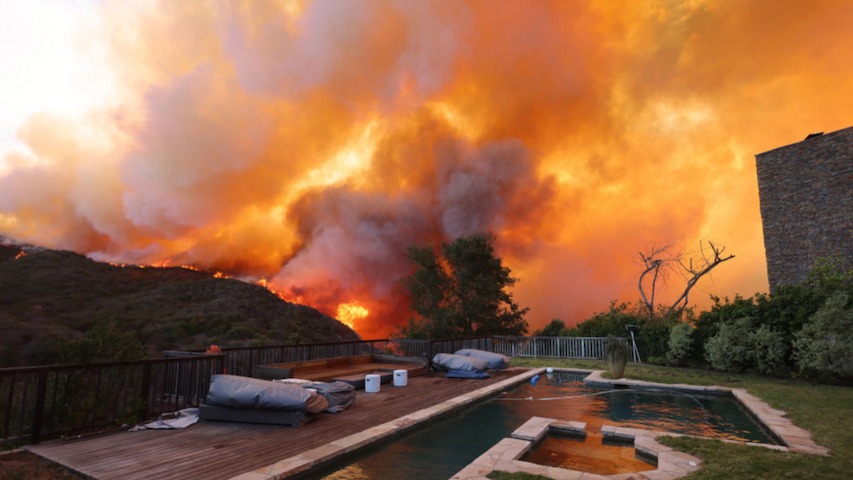Some Things Offer No Retreat
Photo of Palisades Fire by Thewetroadinsummer/Wikimedia Commons
There is a version of one corner of climate change adaptation that makes sense. That is, if you remove many of the social and financial implications, at least — there are simply certain places people should probably not live, should probably not build things, should probably not plant things. A barrier island off the Carolina coast, say, a place that every year is in the crosshairs of increasingly strong storms and a rising sea that, eventually, will laugh off attempts to stay there. A drying African lake bed. A porous limestone peninsula.
The idea of “managed retreat,” where people proactively move away from such increasingly vulnerable places, remains in large part theoretical. It is not unheard of — an eroding Louisiana town here, a low-lying Solomon Islands village there — but for the moment it primarily exists as a measure of last resort.
But importantly, it does exist. An option. If the sea is lapping at your doorstep, or the melting permafrost warping the ground beneath your floor, there is increasing interest and, haltingly, increasing funding and support for leaving the risky area. Moving whole towns, cities, or even countries will be exceptionally difficult and perhaps prohibitively expensive, but the solution is there, tangible, comprehensible: move out of the way.
The problem is, not all the impacts work that way. Torrance, California, is a city of around 140,000 in the Los Angeles metropolitan area, south of L.A.-proper and west of Long Beach. It is not, in general, a climate-vulnerable spot. It has a bit of Pacific coastline, but not much; it sits at an average elevation of around 90 feet, perhaps low enough to worry after a few centuries of Antarctic and Greenland melt, but not yet; it gets hot there, the way much of the region does, but not in a way that might push it toward “unlivable” any time soon.
And on Wednesday, at various points the air in Torrance was considered “unhealthy” or “very unhealthy” or downright “hazardous” to breathe. It happened to sit downwind of the Eaton Fire, the growing behemoth in the hills to the northwest of Pasadena. There are evacuation orders and warnings in the immediate vicinity of that blaze, as well as the Palisades Fire and others still blossoming in the windy tinderbox of greater Los Angeles, but not to the south, where millions more people live and work and, in theory, breathe.
The borders get fuzzy, in these cases. Blurred, debatable, unwieldy. Even if by some economic miracle it was possible to retreat from some of the most fire-prone sections of the L.A. area — the wildland-urban interfaces, the shrub-covered hills and canyons of Simi Valley or Topanga — and leave those spots to be consumed by the flames, none of it stops where we would want it to. Hurricane season demonstrated this recently as well; no one had suggested that Asheville, North Carolina, was some dead-end climate trap.
Also, we will not, of course, simply abandon most of the places that even offer it as a possibility, a means of escape. The average home price in Malibu, which has had a particular dire last few months, is closer to $10 million than to $1 million. And fire, unlike sea level rise, is random enough as to render retreat unreasonable. It is hitting Pacific Palisades today, but it will hit somewhere else tomorrow, and may not be back to this particular spot for years and years. Much like after a hurricane, one might convince oneself to rebuild, to use better materials or different vegetation and so on. To stick it out.
But the fire will be back, at some point, and the people in Torrance, or wherever else that sits firmly outside the Zone of Potential Retreat, will be forced back inside, back under masks, back to the hospital for asthma attacks and heart problems. Most actual retreat from climate change will not be “managed” but chaotic, a response to the latest disaster that, for one reason or another, renders the next disaster unbearable. But we cannot, reasonably, retreat from everywhere, and where do you draw the line, anyway? FEMA’s flood zone maps? Insurance companies’ fire risk assessments?
A picture of the true impact of the fires in L.A. right now is still days away, but right now they look absolutely apocalyptic: fire departments have nowhere near the resources required, fire hydrants are literally empty, thousands of structures have already burned and we don’t even really have a count for good parts of them. It is unlikely, in this particular corner of the world — rich, heavily built up, heavily populated — that “retreat” will emerge from the ashes as much of a viable solution here. And even if it did, the smoke would still blow south, across the city, toward people with nowhere to go.